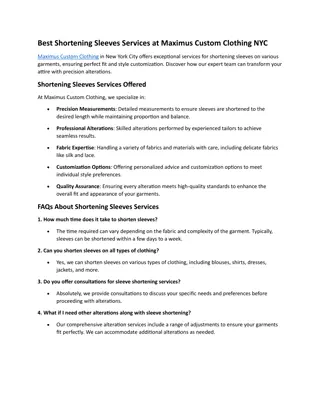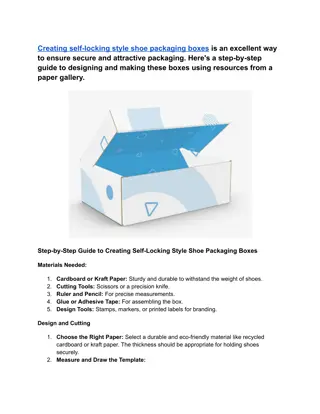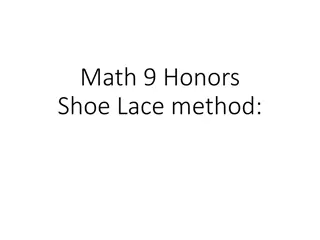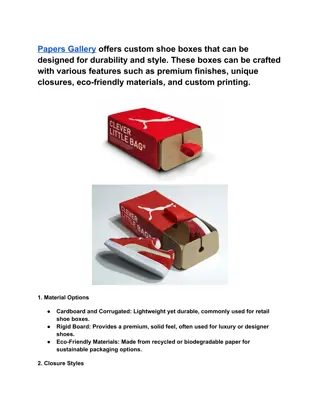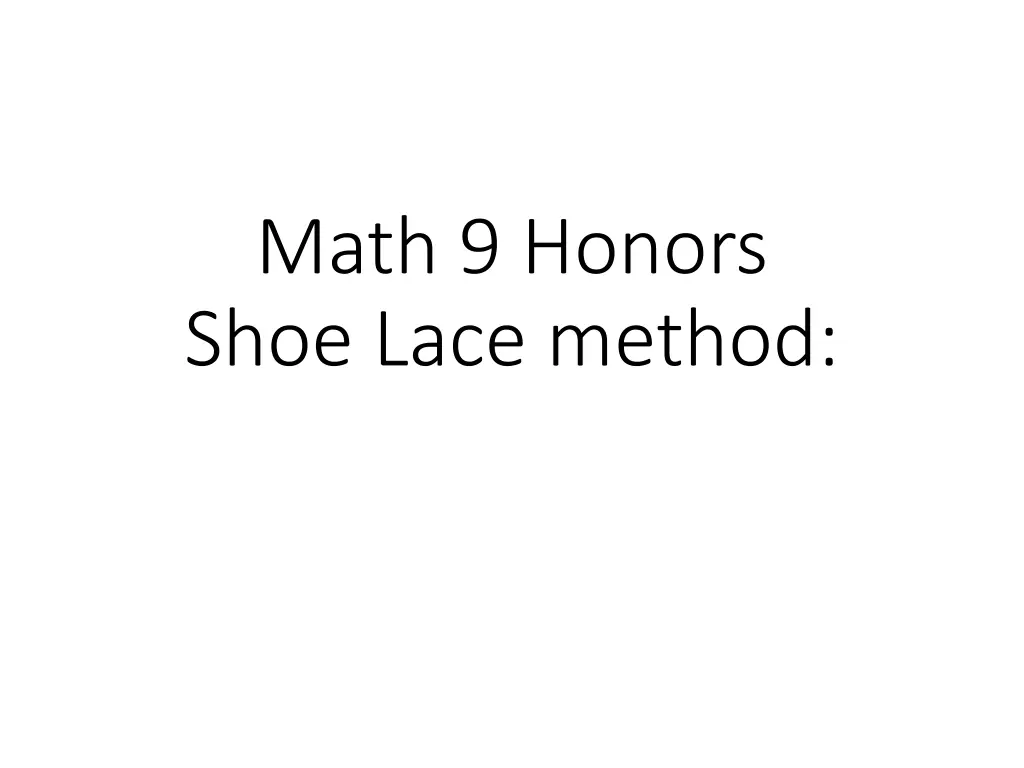
Understanding the Shoe Lace Method in Mathematics
Discover how the Shoe Lace Method is used to find the area of polygons using coordinates of vertices. Learn about determinants, triangle areas, and the process of calculating areas efficiently. Practice examples are included for better comprehension.
Download Presentation

Please find below an Image/Link to download the presentation.
The content on the website is provided AS IS for your information and personal use only. It may not be sold, licensed, or shared on other websites without obtaining consent from the author. If you encounter any issues during the download, it is possible that the publisher has removed the file from their server.
You are allowed to download the files provided on this website for personal or commercial use, subject to the condition that they are used lawfully. All files are the property of their respective owners.
The content on the website is provided AS IS for your information and personal use only. It may not be sold, licensed, or shared on other websites without obtaining consent from the author.
E N D
Presentation Transcript
Math 9 Honors Shoe Lace method:
What is the Shoe Lace Method? The shoe lace method is a process for finding the area of any polygon when you have the coordinates of the vertices 4 2 Place the coordinates in a column, starting in a CW direction = 4 = 18 = 2 6 24 Make sure you repeat the first coordinate that was used Multiply diagonally for each column Add each column: = 3 8 16 48 = 24 = 94 94 = = = 6 6 4 2 ( ) 18 12 70 3,8 Subtract the columns and divide by 2 to get the area ( ) ( ) 6,6 2,6 70 A 2 ( ) 4,2 = 2 12 units
Practice: Find the area of the following shape: Place the coordinates in a column, starting in a CW direction Subtract the columns and divide by 2 to get the area 0 5 Make sure you repeat the first coordinate that was used = 15 = 42 = 30 = 8 = 0 = 0 3 7 = 6 6 18 Multiply diagonally for each column 5 2 4 2 0 5 Add each column: = = = 12 10 20 ( ) 3,7 ( ) 6,6 95 60 ( ) 0,5 95 60 = A 2 ( ) ( ) 5,2 4,2 = 2 17.5 units
Why the Shoe Lace Method Works? (Part 1) The first part of understanding why the Shoe Lace Method works is knowing what a Determinant is: When given two coordinates (a,b) and (c,d), the determinant is: Det bc = ( a c b ad ad d = = of Parallelogram of Triangle Area Area = Det ) 1 2bc a c ( ) a c b d + + , ( )( ) + + + =cd =ab =2ad A A A A A A = = + + + bc 1A a c b ad d cd 2 3 A = + + ab cd 3 d 2 4 5 = 6 A ad b 6 7 a ab A = ( ) , a b 5 A1 ( ) ( cd + ) ( ab bc ) 2 ab ad + bc + + = Parallelogram =Parallelogram A A A A A A 2ad 2 A ( ) A = , c d a 1 + 2 + 3 4 5 6 7 4 2 ab cd ad ad =Parallelogram = 7 A ad d d cd A = 2 2 bc =Parallelogram =Triangle c
Determinant: (bc-ad) Half the determinant of (a,b) and (c,d) will give the area of the triangle created by these two points and the origin 2 6 4 2 Det 1 2 = 2 2) 24 ) 1 2(6 4 ( 2 = 10 = 4 1 If the coordinates are switched, the area becomes negative 4 2 2 6 1 2 = 10 = Just take the absolute value to get the area ( ) 2,6 = 4 6) 4 24 ) Det 1 2(2 2 ( 1 2 ( ) 4,2 ( ) 0,0
How the Shoe Lace Method Works (Part 2) When we use the shoe lace method, we are taking the determinant multiple times 2 6 ( ( ( ( ) ) ) = A = = 1 218 16 1 = 18 = 48 = 16 3 8 1 ( ) 3,8 A = = 1 248 18 15 = 6 6 18 2 ( ) A = A = = 1 224 12 ( ) 24 = 4 = 6 10 6,6 = = 4 2 2 6 12 24 2,6 3 ) 1 24 24 4 ( ) 4,2 = + + 6 10 + A A 1 15 = + 12units = A A A 1 2 + 2 3 4
Practice: Find the area of the shaded regions: Find the point of intersection first =2 = 12 30 5 Diagonal #1: y y x x ( ) ( ) 5,12 30,12 Diagonal #2: 12 35 5 = 2 12 5 60 5 y x = 2 14 y x 2 5 12 30 5 2 + = x y = = = m 1A 5 5 x x + ( ) ?,? ( ) 17.5,7 = = 2 5 5x = x + 5 2 2 2 5 14 5 7 = x = 7 y = 10 70 + 14 y Solve for Intersection point ( ) ( ) 35,0 0,0 x 0 0 5 12 = + 14 y 4 x 210 35 = 0 = 0 = A 1 2 17.5 7 0 0 0 = 210 2 210 = = 35 175 2 A = 17.5 1 = 35 0 175 2 175 = 2 BOTH A
Ratios of a Trapezoid + + = 2 2 2 x y xy Area of Trapezoid 2 x xy xy + + 2xy =25 35 25 5 2 + 35 7 2 12 2 y 2 + 74 5 2 2xy =60 12 2 = 2xy =144 5 74 5 2 175 2 2xy = 2 2 2 x 175 y 25 ( ) ( ) 5,12 30,12 5 = 35 7 2 25 5 2 2 7 = ( ) 35,0 35







